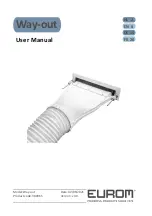
Installation manual
10
E260AC
Domestic hot water tank for air to water heat pump system
4PW64052-1 – 08.2010
M
AINTENANCE
In order to ensure optimal availability of the unit, a number of checks
and inspections on the unit and the field wiring have to be carried out
at regular intervals.
The described checks must be executed at least
once a year
by a
licensed technician.
1
Domestic hot water tank pressure relief valve (field supply)
Check for correct operation of the pressure relief valve on the
domestic hot water tank.
2
Remove the bottom front panel of the water tank to check for
water leaks (first remove the front panel of the indoor unit when
the water tank is mounted on top of the unit).
Descaling
Depending on the water quality and set temperature, scale can
deposit on the heat exchanger inside the domestic hot water tank
and can restrict heat transfer. For this reason, descaling of the heat
exchanger may be required at certain intervals.
Draining
Follow the next steps to drain the domestic hot water tank:
1
Switch off the power supply.
2
Turn off the cold water supply valve.
3
Open the hot water taps.
4
Open the drain valve.
T
ROUBLESHOOTING
This section provides useful information for diagnosing and
correcting certain troubles which may occur in the unit.
General guidelines
Before starting the troubleshooting procedure, carry out a thorough
visual inspection of the unit and look for obvious defects such as
loose connections or defective wiring.
When a safety device was activated, stop the unit and find out why
the safety device was activated before resetting it. Under no
circumstances safety devices may be bridged or changed to a value
other than the factory setting. If the cause of the problem cannot be
found, call your local dealer.
General symptoms
Symptom 1: No water flow from hot taps
Symptom 2: Water from hot taps is cold
Symptom 3: Intermittent water discharge
Symptom 4: Dirty water and water that gives off odours
■
Each inspection has to be carried out by a licensed
technician and
not by the user
.
■
Before carrying out any maintenance or repair activity,
always switch off the circuit breaker on the supply
panel, remove the fuses or open the protection
devices of the unit.
■
Make sure that before starting any maintenance or
repair activity, also the power supply to the outdoor
unit is switched off.
NOTE
The flexible hoses are designed for a 13 year lifetime.
It is adviced to replace them after this period.
When using means for descaling, it must be ensured that
the water quality remains compliant with the requirements
of EU directive 98/83/EC.
When carrying out an inspection on the supply panel or on
the switch box of the unit, always make sure that the circuit
breaker of the unit is switched off.
P
OSSIBLE
CAUSES
C
ORRECTIVE
ACTION
The main water supply is off.
Check that all shut off valves of the
water circuit are completely open.
P
OSSIBLE
CAUSES
C
ORRECTIVE
ACTION
The thermal cut-out located in the
indoor unit has operated
• Check and find the cause of tripping
and then reset button.
• Check if thermistor is correctly
installed in thermistor socket.
Procedure: remove front panel and
insulation, replace or fix the sensor.
The indoor unit is not operating.
Check the indoor unit operation.
Refer to the manual delivered with
the indoor unit.
If any faults are suspected, contact
your local dealer.
P
OSSIBLE
CAUSES
C
ORRECTIVE
ACTION
Thermal control failure (water will be
hot).
Contact your local dealer.
The expansion vessel is broken.
Replace the expansion vessel.
P
OSSIBLE
CAUSES
C
ORRECTIVE
ACTION
Dirty water.
Flush or clean the domestic hot
water tank after periods of standstill.
It could occur that particles in the
water deposit on the bottom of the
tank. If this deposit layer becomes
thick enough it could enter the hot
water outlet and contaminate the hot
water.
The water has a smell of rotten eggs.
Check if this phenomena also occurs
with the cold water. If it does, this
indicates that there is a problem with
the water supply or with the water in
the piping, but not with the domestic
hot water tank itself.
Contact your water supplier.
If the problem is not solved, increase
the domestic hot water tank
temperature above 65°C.
If this action solves the problem, the
smell is most probably caused by
bacterial contamination. Contact
your water supplier.
If the problem is not solved, contact
your local dealer.
4PW64052-1_digital_EN.book Page 10 Monday, August 30, 2010 8:48 AM

































